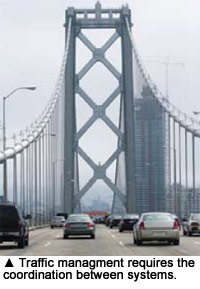The upgrade of the A1 motorway is one of the largest road projects in Poland, aiming to improve safety and quality of service for users. Stretching 90 km from Gdansk to Nowe Marzy, the A1 motorway project — including design, build, maintenance and support — took three years to complete. CS was awarded the contract by Intertoll in 2007, an European operator of highway concessions, to deliver two turnkey systems.
When intelligent transportation technologies work hand in hand, they streamline traffic management and meet commuter needs.
CS Automates Motorway Management
The upgrade of the A1 motorway is one of the largest road projects in Poland, aiming to improve safety and quality of service for users. Stretching 90 km from Gdansk to Nowe Marzy, the A1 motorway project — including design, build, maintenance and support — took three years to complete. CS was awarded the contract by Intertoll in 2007, an European operator of highway concessions, to deliver two turnkey systems.
A traffic management and control system was created, including a 90-km fiber-optic system; emergency call network; counting, weighing and weather stations; a video surveillance system; and an alarm management system dedicated to energy control and fire detection. A toll system for two main and four secondary toll plazas was implemented, installing lane equipment — entry points, a video license plate recognition system and vehicle classification. The toll system included an associated information system integrating transaction management and fraud detection and prevention.
In 2009, CS and Intertoll continued the upgrade from Nowe Marzy to Torun on the A1 motorway. The second phase covered another 63 km, with a new traffic management and control system, and toll system.
Egis Mobilite Unblocks Traffic Congestion
The recurring rush-hour traffic jams along the A48 motorway in France slow down the service of public-transportation. The General Concil of Isère decided to convert a hard shoulder into a shared dedicated lane to resolve this problem. This infrastructure upgrade allows authorized buses to take the hard shoulder under certain conditions. Once the average speed drops under 50 km/h, a shared dedicated lane is opened and bus traffic is allowed. While the average speed exceeds 50 km/h, the shared dedicated lane is closed. Signs are placed at 500-meter intervals to inform users when the shared dedicated lane is open or closed.
This two-year project includes a 3.6-km section of the Lyons-Grenoble motorway, between Saint-Egrève and the Pont d'Oxford. Creating the shared-dedicated lane requires setting up control equipment along the roadway to ensure driver safety.  Integrated operation is possible with a connection to the Gentiane PC, Grenoble's state-managed fast-lane equipment management at the East-Central Interdepartmental Department.
Integrated operation is possible with a connection to the Gentiane PC, Grenoble's state-managed fast-lane equipment management at the East-Central Interdepartmental Department.
Egis Mobilite was the project manage r of the East -Central Interdepartmental Department for the Gentiane operation. It was selected by the General Council of Isère as the full project manager for the shared-dedicated lane project. The construction encompasses the follow phases: project planning, operation procedures drafting, contract assistance, management monitoring, steering and coordination layout, approval of construction designing and working drawings, assistance to receipt operations, and warranty period monitoring.
Setups include fiber-optic cabling, transmission networking, and installation of a video surveillance system, incident detection, traffic counting and signage for road access control.
IBM Breaks City Gridlock
To better align road demand and supply, Stockholm needed an efficient system to meter and charge for road usage. The congestion charging system was launched in January 2006 for a seven-month trial, followed by a public referendum and review by the national government. Based on the success of the trial and positive reviews from the city residents, the government approved making the system permanent with a relaunch in 2007.
IBM was engaged to design, build and operate a fully automated road toll solution that employs advanced optical recognition and RFID technologies. This system automatically taxes Swedish registered vehicles entering and leaving the city center between 6:30 a.m. to 6:30 p.m. on Mondays to Fridays, excluding national holidays.
Each time a vehicle crosses the boundary — either entering or leaving the district — it automatically triggers the onboard RFID transponder of the vehicle. The transponder records the passage, or gateway-mounted cameras photograph the license plates of vehicles not equipped with RFID transponders. Information is sent back to the centralized processing facility to verify vehicle owners' identification and calculate the road usage fee. The fee is then sent as a transaction to the system's core platform, which updates and stores the owner's account information as a database record. To maximize convenience for the public to pay for the fees, the system was also designed to support a number of different payment mechanisms.
During the trial period, the road charging produced a 25 percent reduction in overall traffic volume, estimated to save US$1.1 billion.